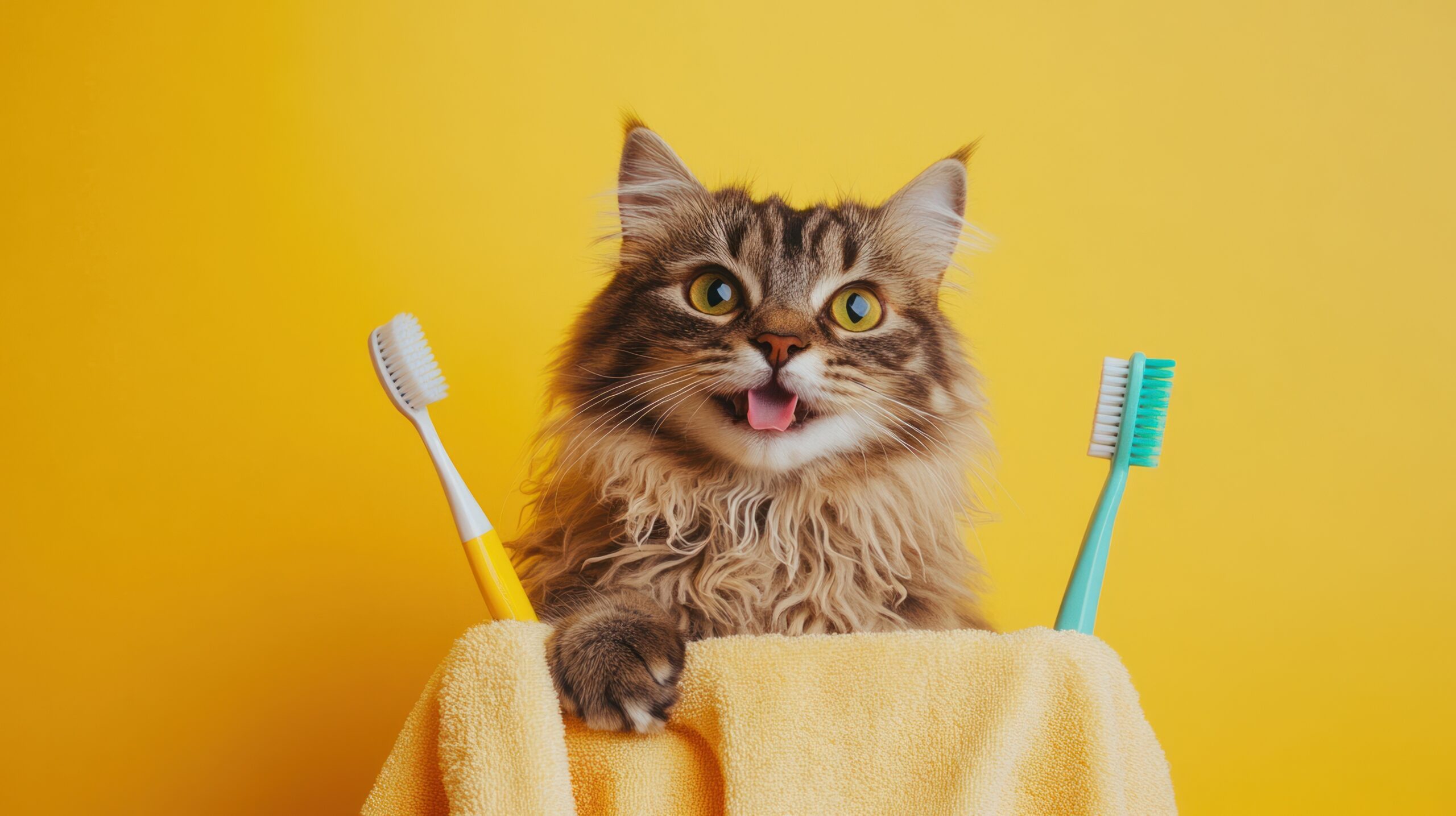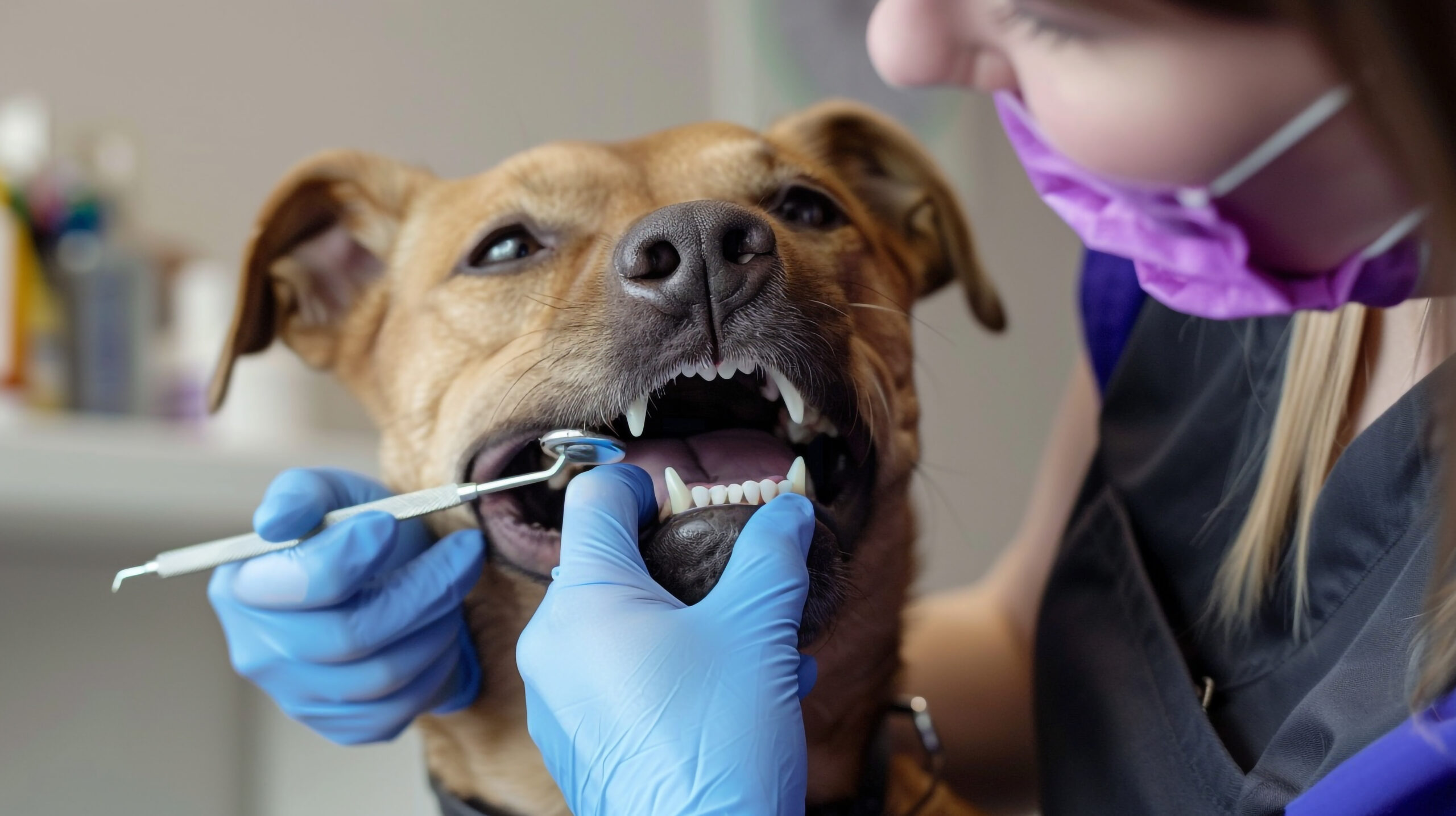Keeping your pet’s teeth in check is super important for their overall health. Just like us, pets require regular dental care to avoid any mouth problems that could impact how they enjoy life. However, many pet owners find it challenging to maintain a stress-free dental care routine for their furry companions.

In this complete guide, you’ll learn how to make pet dental care a calm, simple, and manageable process. Continue reading to learn more!
Understanding the Importance of Pet Dental Care
Dental care isn’t just about maintaining a clean mouth—it’s vital for your pet’s overall health. Poor oral hygiene can lead to severe issues such as infections, heart problems, and kidney disease. Ensuring your pet’s teeth are clean and healthy is crucial in preventing these problems. According to the American Veterinary Dental College, dental disease is one of the most common health issues among pets, particularly tiny dogs.
One of the best ways to keep your pet’s mouth healthy is through regular checkups and cleanings at a vet clinic. For example, the Sunnyside Veterinary Clinic recommends scheduling regular dental cleanings to prevent dental problems. Professional pet dental cleaning can prevent plaque buildup, bad breath, and serious issues like periodontal disease.
Starting Early: Introducing Pets to Dental Care
The earlier you introduce your pet to dental care, the easier it will be for them to adapt. Puppies and kittens are more open to learning new habits, making it an ideal time to introduce tooth brushing and home dental care.
Start by letting your pet sniff the pet toothbrush and taste the dog toothpaste. Then, gently rub your pet’s teeth with your finger, slowly progressing to using a toothbrush. Giving your pet treats or compliments will make this an enjoyable experience for them.
Over time, you’ll notice your pet becoming more comfortable with the routine. While brushing every day is ideal, even a few times a week can help prevent tartar buildup and keep dental problems under control.
Use the Right Dental Products for Your Pet
The quality of dental products you purchase can make all the difference in your pet’s dental care experience. Look for a dog toothbrush with soft bristles designed specifically for pets. Human toothbrushes can be too rough and uncomfortable for pets, especially for smaller dogs and cats. Make sure to use dog toothpaste that’s safe for pets—steer clear of human toothpaste since it has ingredients that can be harmful to your furry friend.
In addition to brushing, other products can help maintain pet dental health. Dental chews, toys, and even water additives can reduce plaque and improve oral hygiene. According to the American Veterinary Dental College, using these products regularly can enhance your pet’s overall dental health, though they should complement, not replace, tooth brushing.
Techniques for Stress-Free Brushing
Getting your pet to let you brush their teeth can be a challenge, but with the proper methods, you can simplify things for both you and your four-legged buddy. Establishing a stress-free routine is vital to maintaining pet dental health and preventing long-term issues like plaque buildup and gum disease. Here’s how to keep your pet calm and comfortable while cleaning your pet’s teeth.
1. Create a Calm Environment
Choose a quiet and familiar spot where your pet feels relaxed and free from distractions. A calm setting makes it easier for your pet to accept new routines like brushing. When your pet feels safe, pet dental cleaning becomes a much more manageable task.
2. Start Slowly and Build Trust
Introduce your pet to pet dental care gradually, starting with gentle touches to their mouth before using a pet toothbrush. Begin by brushing just a few teeth at a time, slowly increasing the duration as your pet becomes more comfortable. Building trust early on ensures long-term success in their dental routine.
3. Use the Right Dental Products
Selecting the right products is essential. Use a pet toothbrush with soft bristles designed for animals, along with pet-friendly toothpaste that your pet will enjoy. Never use human toothpaste, as it can be harmful, and the flavor of pet-specific toothpaste can make pet dental cleaning more enjoyable.
4. Incorporate Positive Reinforcement
Pamper your pet with treats, praise, or toys after each successful brushing session. Positive reinforcement helps your pet associate pet teeth cleaning with something good, reducing resistance over time. This makes it easier to stick to a consistent dental care routine.
5. Break the Process into Small Steps
If your pet is hesitant, break the process into smaller steps, like letting them explore the pet toothbrush or slowly introducing toothpaste. Begin with brief sessions and slowly increase the duration as your pet gets more at ease. This method prevents overwhelm and allows your pet to adjust to the routine at their own pace.
6. Choose the Right Time
Brush your pet’s teeth when they’re in the right mood. Many animals feel calm and relaxed after a meal or a fun game. You can create a dental care routine around these times to help your pet become familiar with regular dental cleaning.
7. Make It a Gentle Process
Use slow, gentle motions to clean your pet’s mouth. Focus on the exposed surfaces of the teeth where plaque tends to build up. Avoid rushing or using excessive force, which can make your pet anxious.
8. Understand Your Pet’s Limits
Each pet is different, and some may require more time to adjust to dental care than others. Recognize when your pet is feeling stressed or resistant, and give them breaks as needed. Gradually work up to longer sessions to avoid overwhelming your pet.
9. Be Consistent
Consistency is critical to avoiding pet dental problems. Ideally, your pet’s toothbrush and mouth-cleaning sessions must happen several times a week. Over time, your pet will become more accustomed to the routine, making pet teeth cleaning a natural part of their life.
If your pet continues to resist brushing, try incorporating dental chews or toys as part of their oral health routine. These can help keep the mouth clean between brushing sessions.
Alternatives to Brushing
If your pet refuses to let you brush its teeth, don’t worry. There are alternative ways to maintain their oral health.
Dental chews are a popular option. These treats are designed to scrape plaque off your pet’s teeth as they chew, reducing the risk of periodontal disease.
Other alternatives include dental wipes, which can be rubbed over your pet’s teeth to remove surface debris, and water additives, which help freshen breath and reduce plaque. However, it’s important to note that these alternatives should not wholly replace brushing but rather act as supplements to your pet’s dental care routine.
The Role of Professional Dental Cleanings
While home dental care is essential, it’s equally important to have your pet undergo professional dental cleanings. These cleanings go beyond what you can achieve at home by removing tartar buildup from below the gumline and detecting potential issues early.
Pets should have regular dental cleanings every year to maintain optimal dental health. During a session, your vet will thoroughly clean your pet’s teeth, remove any plaque and tartar, and inspect for signs of oral health problems.
If necessary, your vet may recommend additional dental procedures such as extractions or treatments for infections. While these can be stressful for both you and your pet, early detection through regular dental cleanings can prevent more severe issues from developing.

Dog dental care. Maintaining healthy dog teeth and gums. Preventing plaque and tartar build-up
Maintaining a Consistent Dental Care Routine
Consistency is vital to maintaining your pet’s dental health. Just like humans, pets benefit from routine oral care that prevents plaque buildup, gum disease, and other dental issues. A routine not only promotes better oral health but also reduces the need for expensive dental procedures in the future.
Here’s how you can create and maintain a stress-free and effective dental care routine for your pet.
1. Set a Regular Schedule
The key to keeping your pet’s dental health in check is consistency. They should try to brush their teeth at least three times a week, but daily brushing is even better. Doing this regularly helps stop plaque and tartar from building up, which can eventually cause gum disease and other dental issues.
It’s essential to set aside a specific time each day for dental care to help your pet get used to the routine. Whether it’s in the morning after feeding or in the evening before bed, stick to a schedule so it becomes a natural part of your pet’s day.
2. Incorporate Dental Care Into Grooming Routines
Dental care doesn’t have to be a separate task. By incorporating it into your pet’s existing grooming routine, you can make it feel less daunting. For example, after a bath or while trimming their nails, please take a few extra minutes to brush their teeth. Grooming sessions tend to relax pets, making it easier to introduce other forms of care like pet teeth cleaning. Over time, your pet will associate grooming with a positive experience, which helps reduce resistance to tooth brushing.
3. Start Slow and Be Patient
If your pet has yet to get used to getting its mouth cleaned, it’s essential to start slowly and be patient. Begin by letting your pet get comfortable with having its mouth touched. You can start by gently rubbing their teeth and gums with your finger before introducing a pet toothbrush.
Also, let them sniff and taste the dog toothpaste before attempting an entire brushing session. Once your pet shows readiness for it, you can gradually brush all of your teeth.
Don’t force it—your pet may need time to adjust. Short, positive brushing sessions over time will help them feel more comfortable, and with enough patience, they’ll eventually become accustomed to regular tooth brushing.
4. Make It a Positive Experience
Positive reinforcement is essential to making your pet’s dental care routine stress-free. Always praise and reward your pet after each successful session. Treats, praise, or a favorite toy can help your pet associate tooth brushing with something enjoyable. When they have fun, your pet will eventually look forward to dental care, making it easier for you in the long run.
How you feel about your pet’s dental routine also matters. When your pet feels that you’re calm and relaxed during the process, it can help them feel less anxious. Keeping the experience fun and rewarding will help create a positive association with dental care.
5. Adapt to Your Pet’s Needs
Every pet is different, and it’s essential to adapt your dental care routine to suit their specific needs. For example, small dogs are more prone to dental problems due to their smaller mouths, which can crowd teeth and lead to tartar buildup more quickly. Larger dogs, on the other hand, may need more durable dental chews or brushes to handle their stronger teeth and gums.
Some pets may also have health conditions that affect their dental care routine. If your pet has sensitive gums, you may need to use a softer brush or focus on gentler methods like dental wipes or water additives. Always consult with your vet to create a routine that works best for your pet’s unique needs.
By creating a consistent and enjoyable dental care routine, you can help your pet maintain healthy teeth and gums throughout its life. Regular brushing, professional cleanings, and the right products will ensure that your pet’s dental health remains stress-free, improving its overall quality of life.
Signs of Dental Problems in Pets
Here are some common symptoms of pet dental health problems to look out for:
- Bad breath: While a slight odor is typical, particularly foul-smelling breath can be a sign of gum disease or infection, indicating the presence of bacteria or decaying food particles in your pet’s mouth.
- Swollen or bleeding gums: Red, swollen, or bleeding gums often indicate inflammation or infection, which could be early signs of gingivitis or more advanced periodontal disease. As with any other dental issue, this can worsen without adequate treatment.
- Difficulty eating: If your pet chews on one side of its mouth, drops food, or avoids harder kibble, it may be experiencing pain due to a dental issue such as a loose tooth, gum infection, or tooth decay.
- Excessive drooling: Drooling more than usual can signal discomfort or irritation in your pet’s mouth. This could be caused by an abscess, a broken tooth, or advanced gum disease that requires immediate attention.
- Loose or missing teeth: Adult pets should not lose teeth, so if you notice missing or loose teeth, it’s often a sign of advanced dental disease. This can lead to difficulty eating and potentially more severe health complications.
By monitoring for these signs and addressing them early, you can help prevent more severe dental problems and ensure that your pet maintains good oral health.
Conclusion
By following the steps outlined in this guide, you can make pet dental care a manageable, stress-free part of your pet’s routine. Whether it’s introducing your pet to tooth brushing, choosing the right dental products, or incorporating alternatives like dental chews, the goal is to keep your pet’s mouth healthy and clean. Regular professional dental cleanings and consistent home dental care are vital in preventing dental disease and ensuring your pet’s long-term health.
Remember, it’s never too early to start focusing on your pet’s dental health. Begin by creating a calm, positive environment for dental care, and soon, your pet will be on the path to better oral hygiene.

